
Author: Mike Smith, Director, National Rock Garden
Extract from National Rock Garden Newsletter No. 16, October 2018
Introduction
Visitors to Portugal are often encouraged to travel by car, bus or train to the east of Lisbon to the regional city of Evora (for example see www.evora-portugal.com/index.html). Évora was an historic trading centre from Roman times, and is now the capital of the south-central Alentejo region. The city contains the ancient Roman Temple of Diana, the nearby massive Gothic Cathedral of Évora, and the curious Igreja de São Francisco, a church which features Gothic and baroque architecture along with the skeleton-adorned Chapel of Bones.
Then there is also the Cromelech of the Almenderes.
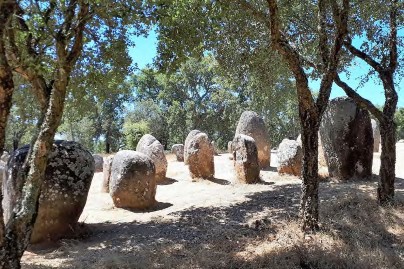
These are very unusual rocks close to the village of Almenderes, about 15 kms west of Evora. They take the form of isolated rocks or clusters of large rocks which are interpreted to have been put in place by people in prehistoric times. Archaeological studies indicate that the placement of the stones and the carvings on them occurred in the Neolithic period, some 7,000 years ago, prior to the building of Stonehenge.
Credit for the discovery in the 1960s goes to a teacher named Henrique Leonor Pina who died in May 2018, and was posthumously awarded the Gold Medal of the City of Evora on June 29, 2018.
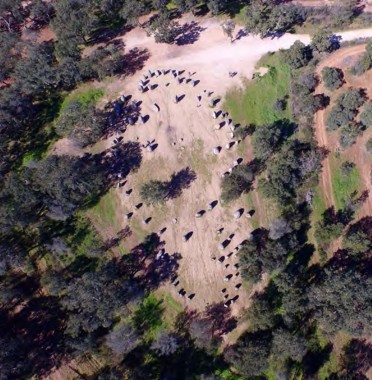
When found, most of the elongate stones were lying on the ground. They have been re-positioned based on archaeological research conducted during the 1970s and 1990s.
The major cluster is on a gentle east-facing slope, with an elliptical axis aiming eastwards, so some kind of solar (sunrise) association has been proposed as being relevant to an agricultural community.
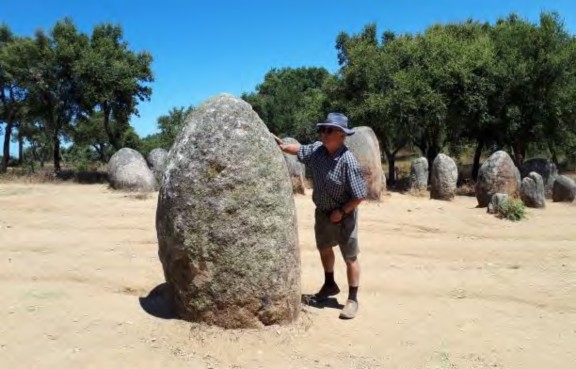
About the granite
The geological map of Portugal (Geological and Mining Institute, 2018) and Pope and Miranda (1999) indicate that many megaliths are associated with an extensive Palaeozoic intrusive complex in the country. The megaliths appear to be the products of natural weathering over millions of years, and that suitably sized residual masses of rock were brought to specific sites. The specimens show no evidence of being dragged so ether they were sourced locally (most likely) or they were transported with great care.
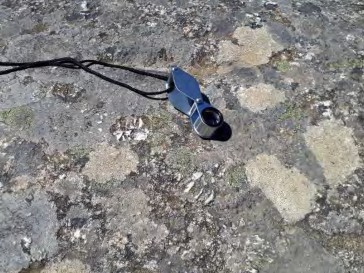
The megaliths are composed of porphyritic granite, as they contain large clumps (phenocrysts) of whitish-pink potassium feldspar. The rock started life as a molten magma deep within the Earth, and stayed there (or rose very slowly) while the ‘phenocrysts’ had time to grow to the size of 10c to 20c pieces. At a later time, the magma was lifted up closer to the cooler Earth’s surface so that the other constituents solidified as finer grained crystals all around the larger feldspar clumps.
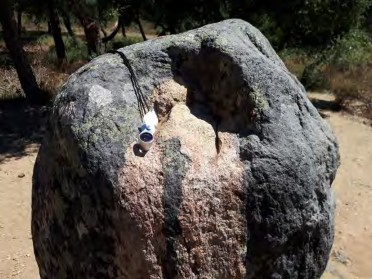
One megalith shows layers (veins) of finer pink crystals, and that material is called an aplite. The crystal of alkali-feldspar and silica are 1–2 mm in size.
These lithological notes about the granite have been provided by Dr Graziella Caprarelli of Hypatia Scientifica, who also made the interesting observation that the granite shows a lot of lichen cover, while the surface of the aplite appears quite clean. This may be due a difference in the chemistry of each material which in turn influenced the rock texture and roughness. The lichens may prefer to make their home on granite due to its mineralogy and its texture.
Carvings
The symbols carved onto many stones are fading due to erosion over the years. Shapes such as circles, arcs, snake-like figures and hooked staffs have been identified but cannot be explained with any certainty.
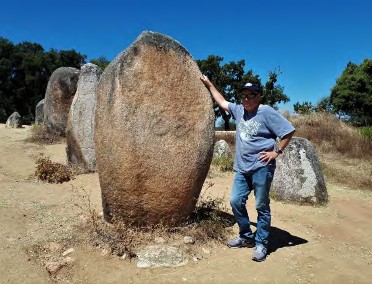
Pope and Miranda (1999) describe the geomorphic characteristics of granite megaliths in southwestern Portugal, noting that megalithic concentrations throughout western Iberia tend to appear in areas where granitic rocks outcrop nearby. This region was relatively undeformed during the Mesozoic and Cenozoic eras, allowing bedrock weathering and erosion to generate spheroidally weathered ‘corestones’ in the more resistant granite.
For those who are interested, good panoramic images of the Comlech of the Almenderes can be found at https://en.wikipedia.org/wiki/Almendres_Cromlech.
References
Broughton, S., 2016. Midsummer Monument: The Sacred Stones Of Portugal’s Stonehenge. https://Www.Independent.Co.Uk/Travel/Europe/Portugal-Evora-Stonehenge-Cromlech-Midsummer-Solstice-Almendres- Zambujeiro-Stone-Circle-A7085496.Html
Geological and Mining Institute, Portugal, 2018. The Geological Map of Portugal. Website: http://www.dct.uminho.pt/cct/progeo2005/docs/map_geol_en.pdf
Pope, G A and Miranda, V C, 1999. A geomorphology of megaliths: Neolithic landscapes in the Alto Alentejo, Portugal. Middle States Geographer, Volume 32, pages 110-124


